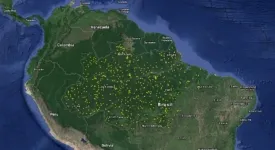World's protected areas need more than a 'do not disturb' sign
2021-04-13
(Press-News.org) Lessons learned from the world's protected forests: Just declaring a plot of land protected isn't enough - conservation needs thoughtful selection and enforcement.
A group of scientists, many tied to Michigan State University, examined nearly 55,000 protected areas across the world to understand what it took to effectively protect their forests - a key benchmark to protecting habitat and preserving natural resources. They conclude that it's important to protect the forests exposed to the most threats in areas close to cities and be prepared to be strict in enforcing rules intended to stop deforestation.
In a recent issue of Science of the Total Environment, researchers noted that more than 4 million square kilometers have been designated as protected areas in the past decade, without documentation of how effective such areas across the globe are at protecting.
Preserving forests means more trees to suck up greenhouse gasses, as well as prevent erosion, mitigate flooding, purify water and quell sandstorms. The paper notes some high-profile protected areas have suffered a loss of wildlife meant to be protected.
"Protecting forests is crucial to achieve sustainability," said Jianguo "Jack" Liu, MSU Rachel Carson Chair in Sustainability and director of the Center for Systems Integration and Sustainability. "To ensure we are directing our efforts to the right places, it's important to scrutinize protected areas across the globe."
In this comprehensive analysis, the study revealed:
About 71% of the protected areas worldwide contributed to preventing forest loss, but there is considerable room for improvement since only 30% of forest loss in protected areas has been prevented.
Protected areas in regions with higher pressure of forest loss prevented more forest loss.
Enforcement is important. At the global scale there is a trade-off between human uses of natural resources and the prevention of forest loss
Private reserves performed similarly to public PAs in preventing forest loss.
The group concluded that declaring an area as protected is not enough and that more attention needs to be given to improving the quality of forest protection and protecting the right forests. Currently, a global pattern of declaring remote areas as protected is missing the target, which instead is better focused on natural areas more in danger of being exploited.
INFORMATION:
In addition to Liu, "A global assessment of the impact of individual protected areas on preventing forest loss" was written by Hongbo Yang, Andrés Viña, Julie Winkler, Min Gon Chung, Qiongyu Huang, Yue Dou and William McShea.
The work was supported by the Smithsonian Institution, the National Science Foundation, Michigan AgBioResearch, the Key Laboratory of Southwest China Wildlife Resources Conservation and the National Natural Science Foundation of China.
[Attachments] See images for this press release:

ELSE PRESS RELEASES FROM THIS DATE:
2021-04-13
In the southern sky, situated about 4,300 light years from Earth, lies RCW 120, an enormous glowing cloud of gas and dust. This cloud, known as an emission nebula, is formed of ionized gases and emits light at various wavelengths. An international team led by West Virginia University researchers studied RCW 120 to analyze the effects of stellar feedback, the process by which stars inject energy back into their environment. Their observations showed that stellar winds cause the region to expand rapidly, which enabled them to constrain the age of the region. These findings indicate that RCW 120 must be less than 150,000 years old, which is very young for such ...
2021-04-13
Behind every heartbeat and brain signal is a massive orchestra of electrical activity. While current electrophysiology observation techniques have been mostly limited to extracellular recordings, a forward-thinking group of researchers from Carnegie Mellon University and Istituto Italiano di Tecnologia has identified a flexible, low-cost, and biocompatible platform for enabling richer intracellular recordings.
The group's unique "across the ocean" partnership started two years ago at the Bioelectronics Winter School (BioEl) with libations and a bar napkin sketch. It has evolved into research published today in Science ...
2021-04-13
Slow down. Baby on board.
So says UBC Okanagan researcher and Associate Professor of Mechanical Engineering Hadi Mohammadi. His new research, conducted in collaboration with Sharif University of Technology, determines that accelerating over speed bumps poses a danger for pregnant women and their fetuses.
"There is lots of research about the importance of movement for women during pregnancy," explains Mohammadi, who teaches in the School of Engineering. "Our latest research looked specifically at the impacts of sudden acceleration on a pregnant woman."
Using new modelling based on data from ...
2021-04-13
When the Webster-Kirkwood Times, a community newspaper in the greater St. Louis, Missouri area, had to endure layoffs and stop publishing its print edition -- due to a loss in revenue as a result of the COVID-19 pandemic -- its readers felt the loss and began supporting the newspaper in earnest.
"A lot of times people don't know what they've got until it's gone," said Jaime Mowers, editor-in-chief of the Webster-Kirkwood Times. "Now, there is such a newfound appreciation for the newspaper. It's amazing to have the community's support, knowing we are loved that much and appreciated enough to ...
2021-04-13
BUFFALO, N.Y. - Mindfulness is big business. Downloads of mindfulness apps generate billions of dollars annually in the U.S., and their popularity continues to rise. In addition to what individual practitioners might have on their phones, schools and prisons along with 1 in 5 employers currently offer some form of mindfulness training.
Mindfulness and meditation are associated with reducing stress and anxiety, while increasing emotional well-being. Plenty of scholarship supports these benefits. But how does mindfulness affect the range of human behaviors -- so-called prosocial behaviors -- that can potentially help or benefit other people? What happens when the research looks outwardly at social effects of mindfulness rather than inwardly at its personal effects?
It's ...
2021-04-13
Human screams signal more than fear and are more acoustically diverse than previously thought, according to a study published April 13th 2021 in the open-access journal PLOS Biology by Sascha Fru?hholz of the University of Zurich, and colleagues. Remarkably, non-alarming screams are perceived and processed by the brain more efficiently than alarming screams.
In nonhuman primates and other mammalian species, scream-like calls are frequently used as an alarm signal exclusively in negative contexts, such social conflicts or the presence of predators or other environmental threats. Humans are also assumed to use screams to signal danger and to scare predators. But humans scream not only when they are ...
2021-04-13
First study to examine suicides occurring around the world during the COVID-19 pandemic finds that - in high-income and upper-middle-income countries - suicide numbers have remained largely unchanged or have declined in the early months of the pandemic, compared with expected levels.
However, the authors stress that governments must remain vigilant as the longer-term mental health and economic effects of the pandemic unfold and be poised to respond if the situation changes.
Study looked at numbers of suicides in 21 countries between 1 April and 31 July 2020 and compared these with trends in the previous one to four years.
A new observational study ...
2021-04-13
Screaming can save lives. Non-human primates and other mammalian species frequently use scream-like calls when embroiled in social conflicts or to signal the presence of predators and other threats. While humans also scream to signal danger or communicate aggression, they scream when experiencing strong emotions such as despair or joy as well. However, past studies on this topic have largely focused on alarming fear screams.
Humans respond to positive screams more quickly and with higher sensitivity
In a new study, a team at the University of Zurich Department of Psychology led by Sascha Frühholz ...
2021-04-13
Living near a hazardous waste or Superfund site could cut your life short by about a year, reports Hanadi S. Rifai, John and Rebecca Moores Professor of Civil and Environmental Engineering at the University of Houston. The study, published in Nature Communications and based on evaluation of 65,226 census tracts from the 2018 Census, is the first nationwide review of all hazardous waste sites and not just the 1,300 sites on the national priority list managed by the federal government.
The analysis shows a decrease of more than two months in life expectancy for those living near a Superfund site. When coupled with high disadvantage of sociodemographic factors like age, sex, marital status and income, the decrease could be nearly 15 months, ...
2021-04-13
A group of researchers led by Brazilians has used an innovative model to map gaps in the Amazon rainforest and identify factors that contribute to tree mortality. Water stress, soil fertility, and anthropic forest degradation have the most influence on gap dynamics in the world's largest and most biodiverse tropical rainforest, according to an article on the study published in Scientific Reports.
Forest gaps are most frequent in the areas with the highest levels of soil fertility, possibly because the abundance of organic material drives faster tree growth and shorter life cycles.
The main method of data collection ...
LAST 30 PRESS RELEASES:
[Press-News.org] World's protected areas need more than a 'do not disturb' sign






